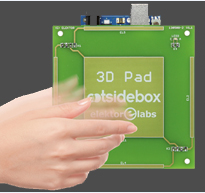3Dpad - touchless gesture controller Arduino shield - by www.ootsidebox.com
I'll try to answer into this page, and also I'll explain some hacks I've just done in order to shape it: smaller and bigger.
The modifications are only on the electrodes, nothing changed on the schematics, bill of material and software.
We define the perception area as a geometric zone where 3Dpad can sense the proximity of your hand or finger. The more accurate area where 3Dpad can calculate a 3D position is a little bit smaller.
The standard shape
Let's start with the standard shape, without modifying the electrodes' PCB.
Looking at the drawing below, you can see the perception area as a kind of water drop, slightly crushed on the top of the electrodes' PCB surface.
The depth perception (H) is around 10 centimeters, and there is a lateral perception (W) of around 14 centimers from the center.
A reduced shape
I made a prototype of this kind for an application where there is not enough place to put the 90x90mm electrodes' PCB. In this future product, we have the possibility of only 40x40 millimeters for the whole system, and there is a LED (square) at the center. Here is the plan of the electrodes' PCB that I used for the experiment:
There is a grounded copper around the perception area, so the sensing lateral distance is reduced.
Here is the result:
Augmenting the perception area
I made it in the simplest way,extending the electrodes's dimension by using copper wire, directly soldered on the PCB:
This is what the new interaction area looks like now:
As you can imagine, the sensing area is also increased at the back side now, because the electrodes' extention is made of wire "in the air", sorry I didn't measure it for now.
Well, in this configuration it makes me think about a new kind of Theremin, augmented with a third dimension on each sensing plate (a Theremin has two antenna: one for the pitch and the other for volume control). In more I guess it will be easy to continue increasing the geometry, there should be only small changes on some resistor values, and software adjustment.
See it in action:
See also:













.jpg.855x570_q85_pad_rcrop.jpg)







